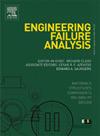Innovative non-destructive thermographic evaluation of mechanical properties in dissimilar aluminium probeless friction stir spot welded (P-FSSW) joints
IF 4.4
2区 工程技术
Q1 ENGINEERING, MECHANICAL
引用次数: 0
Abstract
This study introduces a novel non-destructive methodology based on step-heating laser thermography technique to evaluate the mechanical strength of dissimilar aluminium joints produced through probeless friction stir spot welding (P-FSSW). The proposed approach enables the quantitative analysis of the thermo-mechanically stirred region, distinguishing two different morphologies (ductile and mixed) correlated with the joint’s ultimate mechanical strength. Eleven welded joints were analysed by using two of them used for calibration through thermographic tests, Chisel and scanning electron microscopy (SEM) analyses. At the same time, nine underwent tensile-shear tests were carried out to correlate thermographic parameters (A1, A2) with maximum force (Fmax).
Statistical analysis revealed that the ductile area (A2) is the most significant parameter, exhibiting a robust correlation with Fmax (r = 0.81). A simplified regression model based on A2 demonstrated high reliability (adjusted R2 = 0.60). This methodology provides a significant advancement in non-destructive quality control for P-FSSW joints, paving the way for its integration into industrial applications. The developed procedure offers a reliable, contactless, and scalable solution for real-time industrial inspection of P-FSSW joints, representing a significant alternative to conventional destructive testing methods.
异种铝无探针搅拌摩擦点焊(P-FSSW)接头力学性能的创新无损热成像评价
介绍了一种基于步进加热激光热成像技术的新型非破坏性方法,用于评估无探针搅拌摩擦点焊(P-FSSW)生产的异种铝接头的机械强度。该方法能够对热机械搅拌区域进行定量分析,区分与接头极限机械强度相关的两种不同形态(延性和混合性)。对11个焊接接头进行了分析,其中两个用于通过热像仪测试、凿子和扫描电子显微镜(SEM)分析进行校准。同时,进行了9个拉伸-剪切试验,以将热成像参数(A1, A2)与最大力(Fmax)相关联。统计分析表明,延性面积(A2)是最显著的参数,与Fmax具有较强的相关性(r = 0.81)。基于A2的简化回归模型具有较高的信度(调整后R2 = 0.60)。该方法为P-FSSW接头的无损质量控制提供了重大进展,为其集成到工业应用中铺平了道路。开发的程序为P-FSSW接头的实时工业检测提供了可靠、无接触和可扩展的解决方案,代表了传统破坏性检测方法的重要替代方案。
本文章由计算机程序翻译,如有差异,请以英文原文为准。
求助全文
约1分钟内获得全文
求助全文
来源期刊

Engineering Failure Analysis
工程技术-材料科学:表征与测试
CiteScore
7.70
自引率
20.00%
发文量
956
审稿时长
47 days
期刊介绍:
Engineering Failure Analysis publishes research papers describing the analysis of engineering failures and related studies.
Papers relating to the structure, properties and behaviour of engineering materials are encouraged, particularly those which also involve the detailed application of materials parameters to problems in engineering structures, components and design. In addition to the area of materials engineering, the interacting fields of mechanical, manufacturing, aeronautical, civil, chemical, corrosion and design engineering are considered relevant. Activity should be directed at analysing engineering failures and carrying out research to help reduce the incidences of failures and to extend the operating horizons of engineering materials.
Emphasis is placed on the mechanical properties of materials and their behaviour when influenced by structure, process and environment. Metallic, polymeric, ceramic and natural materials are all included and the application of these materials to real engineering situations should be emphasised. The use of a case-study based approach is also encouraged.
Engineering Failure Analysis provides essential reference material and critical feedback into the design process thereby contributing to the prevention of engineering failures in the future. All submissions will be subject to peer review from leading experts in the field.
 求助内容:
求助内容: 应助结果提醒方式:
应助结果提醒方式:


